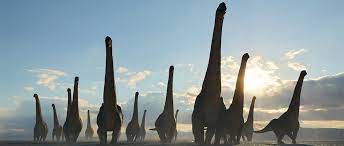I haven’t seen Prehistoric Planet, a documentary series on Apple TV+ that takes viewers on a “guided tour” of what things looked like when dinosaurs roamed the earth. The series, which has gotten rave reviews, combines the latest fossil-based research with the latest visual effects technology to produce something that apparently comes as close as it can get to what it actually looked like way back when. From what I’ve read about it, the level of detail and authenticity is so great that it makes Jurassic Park look like the Flintstones, the cartoon series dating from the 1960’s. I.e., my pre-history. (Not to make anyone feel old, but Jurassic Park, which when we first saw it struck us all as amazingly authentic, was released 29 years ago. Today’s technology for analyzing fossil records, not to mention 3D and CGI technology, is so much more sophisticated than what was available 30 years back.)
In addition to taking advantage of leading-edge technology, to make Prehistoric Planet seem even more like a realistic nature documentary, it’s narrated by Sir David Attenborough, whose voice is familiar from a slew of documentary series about animal and plant life here on earth.
Interestingly, the creators didn’t replicate the landscapes used in the series. They filmed the backgrounds in real-world locations that were similar to Cretaceous period habitats. They went on site to jungles and deserts, and “used life-size physical objects, such as cardboard cutouts and 3D-printed puppets, as stand-ins for the long-extinct dinosaurs.”
Admittedly, cardboard cutouts and 3D puppets don’t sound like cutting edge technology – other than shadow puppets, I’m pretty sure that all puppets are 3D – but they served their purpose, enabling the filmmakers and special effects crews to figure out how the dinosaurs could navigate in their environment: how much space they’d occupy, how they’d move about. For the larger animals “the team used long boom poles and drones to capture the eye-line and scale of really giant creatures.”
There was plenty of technology (and science) put to use:
The crew didn’t just have cameras and stand-in models; they were also equipped with laser-shooting light detection and ranging (lidar) scanners for modeling environments, and high dynamic range (HDR)
imaging equipment to measure light, enabling visual effects specialists to recreate natural environments and lighting in 3D space when adding the CGI dinosaurs.
The visual effects team designed the dinosaurs on computers, starting with skeletons based on fossil scans, and then adding muscles and skin. The appearance, motion and behavior of the dinosaurs were inspired by evidence from paleontology, contemporary biology and other scientific disciplines such as biomechanics — the study of biological structures and mechanisms that control how animals move. (Source: Live Science)
While the creators drew on extensive fossil records:
When the fossil evidence didn’t have all the answers, the team used a scientific technique known as phylogenetic bracketing. This practice enabled them to infer the likelihood of unknown dinosaur traits — such as vocalizations or other kinds of social behavior — based on the characteristics of related animals in their family tree, or of unrelated animals with a similar lifestyle.
(Am I the only one who kind of chuckled when they read about the animals’ “lifestyles?”)
For example, the team looked at crocodiles, iguanas and birds for inspiration when animating the movement of a T. rex‘s head during a courtship scene in the “Freshwater” episode, and the creators referenced large herbivores such as elephants and rhinos to inform the movements of extinct herbivores such as Dreadnoughtus.
Anyway, I’m sold! Who doesn’t love dinosaurs? Looking forward to seeing Prehistoric Planet. I may even watch the original Jurassic Park for a compare and contrast. But I will likely draw the line at digging up an old Flintstones cartoon. I don’t think there’s any science behind humans – even cartoon humans – like the Flintstones and the Rubbles co-existing with dinosaurs. Yabba-dabba-do.

 imaging equipment to measure light, enabling visual effects specialists to recreate natural environments and lighting in 3D space when adding the CGI dinosaurs.
imaging equipment to measure light, enabling visual effects specialists to recreate natural environments and lighting in 3D space when adding the CGI dinosaurs.